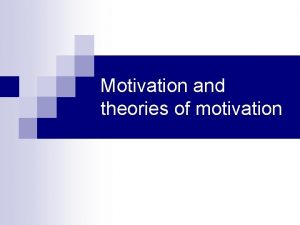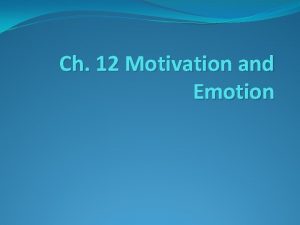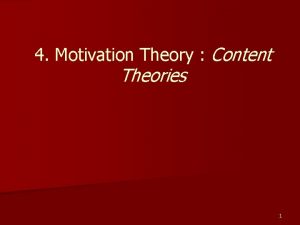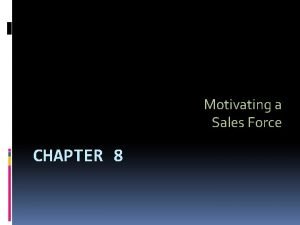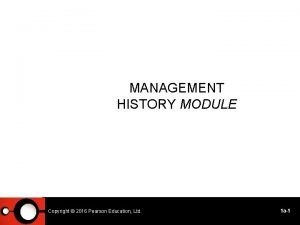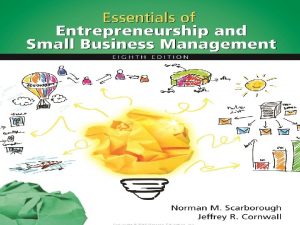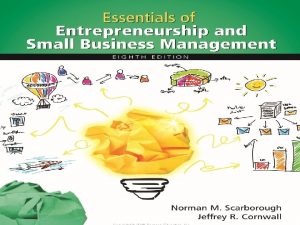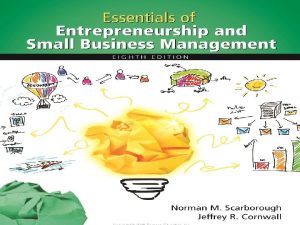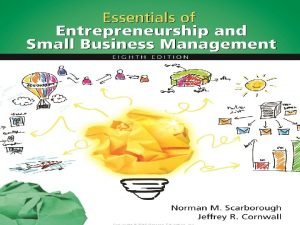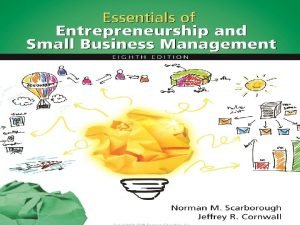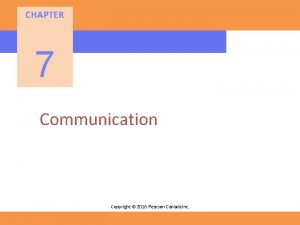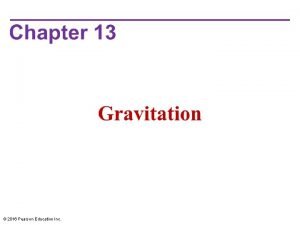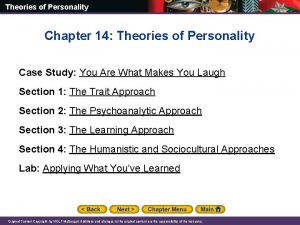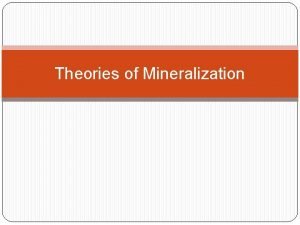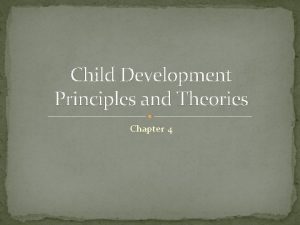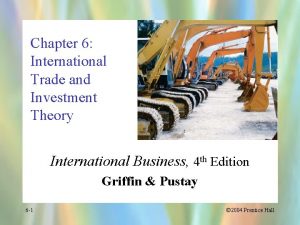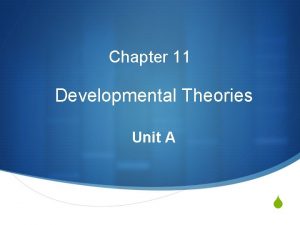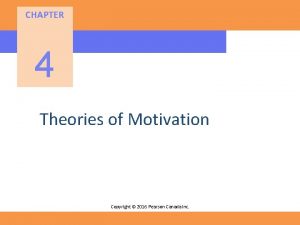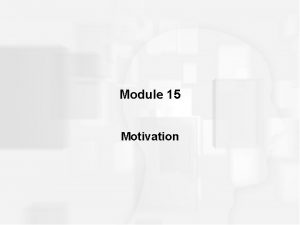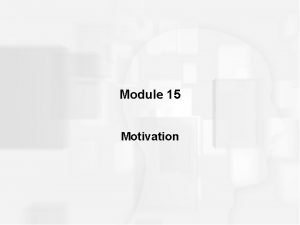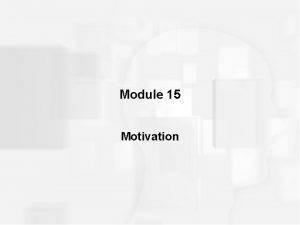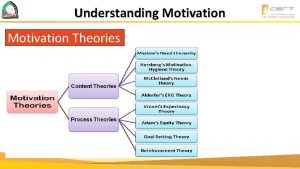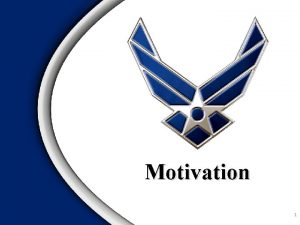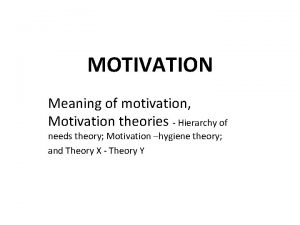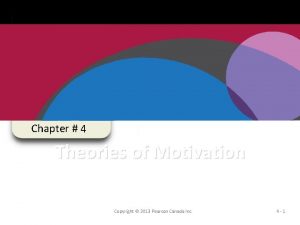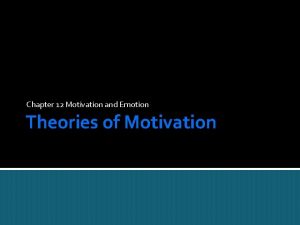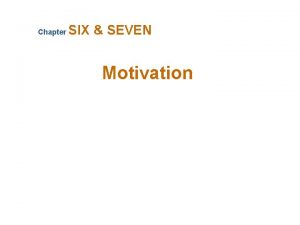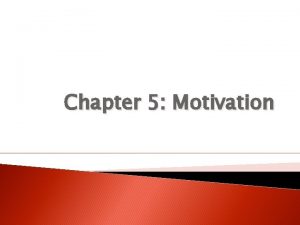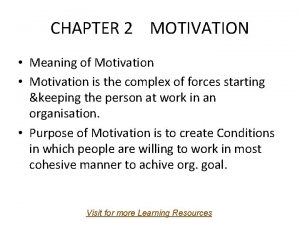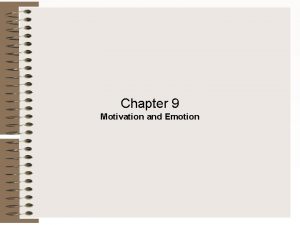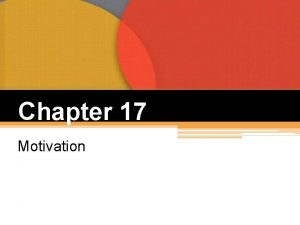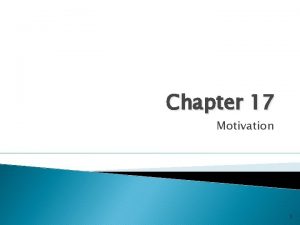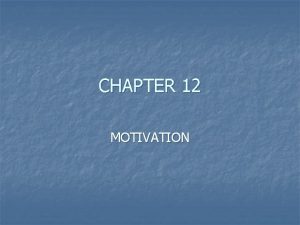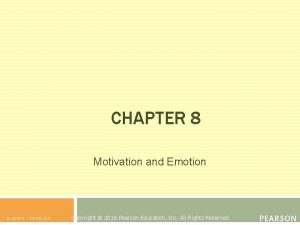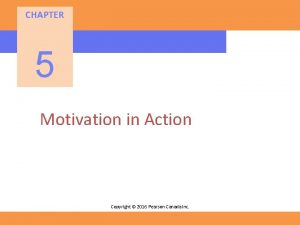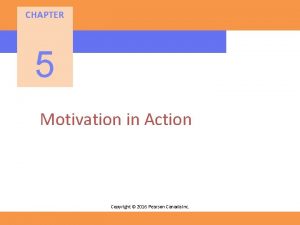CHAPTER 4 Theories of Motivation Copyright 2016 Pearson





























































- Slides: 61

CHAPTER 4 Theories of Motivation Copyright © 2016 Pearson Canada Inc.

Chapter Outline • What Is Motivation? • Needs Theories of Motivation – Maslow’s Hierarchy of Needs Theory – Motivation-Hygiene Theory – Mc. Clelland’s Theory of Needs – Summarizing Needs Theories • Process Theories of Motivation – Expectancy Theory – Goal-Setting Theory – Self-Efficacy Theory – Reinforcement Theory Copyright © 2016 Pearson Canada Inc.

Chapter Outline • Responses to the Reward System – Equity Theory – Fair Process and Treatment – Self-Determination Theory – Increasing Intrinsic Motivation • Motivation for Whom? – Putting it all Together Copyright © 2016 Pearson Canada Inc.

Learning Outcomes 1. Describe three key elements of motivation. 2. Evaluate the applicability of early theories of motivation. 3. Apply the key tenets of expectancy theory to motivating employees. 4. Describe goal-setting theory, self-efficacy theory, and reinforcement theory. 5. Describe why equity and fairness matter in the workplace. Copyright © 2016 Pearson Canada Inc.

Learning Outcomes 6. Demonstrate how organizational justice is a refinement of equity theory. 7. Apply the predictions of self-determination theory to intrinsic and extrinsic rewards. 8. Discuss the ethics behind motivation theories. 9. Summarize the essence of what we know about motivating employees. Copyright © 2016 Pearson Canada Inc.

What Is Motivation? • Motivation – The intensity, direction, and persistence of effort a person shows in reaching a goal: • Intensity: How hard a person tries • Direction: Where effort is channelled • Persistence: How long effort is maintained Copyright © 2016 Pearson Canada Inc.

Theory X and Theory Y • Theory X Assumptions • Theory Y Assumptions – Employees dislike work – Employees like to work – Employees attempt to avoid work – Employees are creative, and seek responsibility – Employees must be coerced, controlled, or threatened with punishment to achieve goals. – Employees will exercise selfdirection and self-control if they are committed to the objectives. Copyright © 2016 Pearson Canada Inc.

Motivators • Intrinsic Motivators – A person’s internal desire to do something • interest, challenge, and personal satisfaction • Extrinsic Motivators – Motivation that comes from outside the person • pay, bonuses, and other tangible rewards Copyright © 2016 Pearson Canada Inc.

Needs Theories of Motivation • Basic idea – Individuals have needs that, when unsatisfied, have the potential to create motivation • Maslow’s Hierarchy of Needs Theory • Herzberg’s Motivation-Hygiene Theory • Alderfer’s ERG Theory • Mc. Clelland’s Theory of Needs Copyright © 2016 Pearson Canada Inc.

Maslow’s Hierarchy of Needs • Physiological – Includes hunger, thirst, shelter, sex, and other bodily needs • Safety – Includes security and protection from physical & emotional harm • Social – Includes affection, belongingness, acceptance, and friendship • Esteem – Includes internal esteem factors: self-respect, autonomy, and achievement – Includes external esteem factors: status, recognition, and attention • Self-actualization – The drive to become what one is capable of becoming – Includes growth, achieving one’s potential, and self-fulfillment Copyright © 2016 Pearson Canada Inc.

Exhibit 4 -1 Maslow’s Hierarchy of Needs Copyright © 2016 Pearson Canada Inc.

Herzberg’s Motivation-Hygiene Theory • Motivators • Hygiene factors – Sources of satisfaction – Intrinsic factors (content of work) • Achievement • Recognition • Challenging, varied, or interesting work • Responsibility • Advancement • Growth – Sources of dissatisfaction – Extrinsic factors (context of work) • Company policy and administration • Unhappy relationship with employee’s supervisor • Poor interpersonal relations with one’s peers • Poor working conditions Copyright © 2016 Pearson Canada Inc.

Exhibit 4 -2 Comparison of Satisfiers and Dissatisfiers Copyright © 2016 Pearson Canada Inc.

Exhibit 4 -3 Contrasting Views of Satisfaction and Dissatisfaction Copyright © 2016 Pearson Canada Inc.

Criticisms of Motivation-Hygiene Theory • Procedure Herzberg used is limited by its methodology. • Reliability of Herzberg’s methodology is questioned. • No overall measure of satisfaction was used. • Herzberg assumed that a relationship exists between satisfaction and productivity. Copyright © 2016 Pearson Canada Inc.

Mc. Clelland’s Theory of Needs • Need for achievement – The drive to excel, to achieve in relation to a set of standards, to strive to succeed • Need for power – The need to make others behave in a way that they would not have behaved otherwise • Need for affiliation – The desire for friendly and close interpersonal relationships Copyright © 2016 Pearson Canada Inc.

Exhibit 4 -4 Relationship of Various Needs Theories Copyright © 2016 Pearson Canada Inc.

Summary: Hierarchy of Needs • All the need theories propose a similar idea: Individuals have needs that, when unsatisfied, have the potential to create motivation. • Maslow: Argues that lower-order needs must be satisfied before one progresses to higher-order needs. • Herzberg: Motivators lead to satisfaction. Hygiene factors must be met if person is not to be dissatisfied. However, they will not lead to satisfaction. • Alderfer: More than one need can be important at the same time. If a higher-order need is not being met, the desire to satisfy a lower-level need increases. • Mc. Clelland’s: People vary in the types of needs they have. Their motivation and how well they perform in a work situation are related to whether they have a need for achievement, affiliation, or power. Copyright © 2016 Pearson Canada Inc.

Summary: Impact of Theory • Maslow: Enjoys wide recognition among practising managers. Most managers are familiar with it. • Herzberg: The popularity of giving workers greater responsibility for planning and controlling their work can be attributed to his findings. Shows that more than one need may operate at the same time. • Alderfer: Seen as a more valid version of the need hierarchy. Tells us that achievers will be motivated by jobs that offer personal responsibility, feedback, and moderate risks. • Mc. Clelland: Tells us that high need achievers do not necessarily make good managers, since high achievers are more interested in how they do personally. Copyright © 2016 Pearson Canada Inc.

Summary: Support and Criticism of Theory • Maslow: Research does not generally validate theory. In particular, there is little support for the hierarchical nature of needs. Criticized for how data were collected and interpreted. • Herzberg: Not really a theory of motivation: Assumes a link between satisfaction and productivity that was not measured or demonstrated. • Alderfer: Ignores situational variables. • Mc. Clelland’s: Mixed empirical support, but theory is consistent with our knowledge of individual differences among people. Good empirical support, particularly on needs achievement. Copyright © 2016 Pearson Canada Inc.

Process Theories of Motivation • Look at the actual process of motivation – Expectancy theory – Goal-setting theory – Self-efficacy theory Copyright © 2016 Pearson Canada Inc.

Expectancy Theory • The theory that employees will be motivaated to exert a high level of effort if they believe the following: – That their effort will lead to good performance – That good performance will be followed by a given outcome (organizational rewards such as salary increase) – That the reward will satisfy employee’s personal goals Copyright © 2016 Pearson Canada Inc.

Expectancy Relationships • The theory focuses on three relationships: – Effort-Performance Relationship (Expectancy) • The perceived probability that exerting a given amount of effort will lead to performance – Performance-Reward Relationship (Instrumentality) • The degree to which the individual believes that performing at a particular level will lead to organizational rewards – Rewards-Personal Goals Relationship (Valence) • The degree to which organizational rewards satisfy an individual’s personal goals or needs and are attractive to the individual Copyright © 2016 Pearson Canada Inc.

Exhibit 4 -7 Steps to Increasing Motivation, Using Expectancy Theory Copyright © 2016 Pearson Canada Inc.

Importance of Providing Performance Feedback • An effective performance review: – Employee perceives the appraisal as fair – Manager is sincere – Climate is constructive • Performance review should be more like a counselling activity than a judgment process, allowing the review to evolve out of the employee’s own self-evaluation. Copyright © 2016 Pearson Canada Inc.

Goal-Setting Theory • The theory that specific and difficult goals lead to higher performance. – Goals tell an employee what needs to be done and how much effort will need to be expended. • Specific goals increase performance. • Difficult goals, when accepted, result in higher performance than do easy goals. • Feedback leads to higher performance than does non-feedback. – Specific hard goals produce a higher level of output than does the generalized goal of “do your best. ” • The specificity of the goal itself acts as an internal stimulus. Copyright © 2016 Pearson Canada Inc.

Management by Objectives • A program that encompasses: – Specific goals (tangible, verifiable, and measurable) – Participative decision-making – Explicit time period – Performance feedback Copyright © 2016 Pearson Canada Inc.

How Does Goal Setting Motivate? • Goals: – Direct attention – Regulate effort – Increase persistence – Encourage the development of strategies and action plans Copyright © 2016 Pearson Canada Inc.

Goals Should Be SMART • For goals to be effective, they should be SMART: – Specific – Measurable – Attainable – Results Oriented – Time bound Copyright © 2016 Pearson Canada Inc.

Exhibit 4 -8 Locke’s Model of Goal Setting Copyright © 2016 Pearson Canada Inc.

Goal Setting Theory • People differ in the way they regulate their thoughts and behaviours during goal pursuit • Promotion Focus – strive for advancement and accomplishment and approach conditions that move them closer toward desired goals • Prevention Focus – strive to fulfill duties and obligations and avoid conditions that pull them away from desired goals Copyright © 2016 Pearson Canada Inc.

Self-Efficacy Theory • Self Efficacy also known as social cognitive theory and social learning theory • An individual’s belief that he or she is capable of performing a task. – The higher your self efficacy the more confident you are in your ability to succeed in a task Copyright © 2016 Pearson Canada Inc.

Four Ways to Improve Self Efficacy • Enactive Mastery – Gaining relevant experience • Vicarious Modelling – Confidence gained by seeing someone else perform the task. • Verbal Persuasion – Confidence gained because someone convinces you that you have the necessary skills to succeed. • Arousal – An energized state can drive a person to complete the task. Copyright © 2016 Pearson Canada Inc.

Exhibit 4 -9 Joint Efforts of Goals and Self Efficacy on Performance Copyright © 2016 Pearson Canada Inc.

Motivating Through Reinforcement • Skinner suggested that people learn how to behave to get something they want or to avoid something they don’t want. • This idea is known as operant conditioning. – Behaviour is influenced by the reinforcement or lack of reinforcement brought about by the consequences of the behaviour. Copyright © 2016 Pearson Canada Inc.

Methods of Shaping Behaviour • Positive reinforcement – Following a response with something pleasant. • Negative reinforcement – Following a response by the termination or withdrawal of something unpleasant. • Punishment – Causing an unpleasant condition in an attempt to eliminate an undesirable behaviour. • Extinction – Eliminating any reinforcement that is maintaining a behaviour. Copyright © 2016 Pearson Canada Inc.

Exhibit 4 -10 Types of Reinforcement Copyright © 2016 Pearson Canada Inc.

Schedules of Reinforcement • The two major types of reinforcement schedules are continuous and intermittent. – Continuous reinforcement: reinforces desired behaviour each and every time it is demonstrated. – Intermittent reinforcement: ratio or interval • The individual is reinforced after giving a certain number of specific types of behaviour. • The individual is reinforced on the first appropriate behaviour after a particular time has elapsed. Copyright © 2016 Pearson Canada Inc.

Fixed and Variable Reinforcements • A reinforcement can also be classified as fixed or variable. – Fixed-interval schedule – Variable-interval schedule – Fixed-ratio schedule – Variable-ratio schedule Copyright © 2016 Pearson Canada Inc.

Exhibit 4 -11 Schedules of Reinforcement Copyright © 2016 Pearson Canada Inc.

Responses to the Reward System • Equity Theory • Fair Process and Treatment • Self-Determination Theory • Increasing Intrinsic Motivation Copyright © 2016 Pearson Canada Inc.

Exhibit 4 -12 Equity Theory Copyright © 2016 Pearson Canada Inc.

Equity Theory • Equity theory recognizes that individuals are concerned not only with the absolute amount of rewards for their efforts, but also with the relationship of this amount to what others receive. • Individuals compare their job inputs and outcomes with those of others and then respond so as to eliminate any inequities. Copyright © 2016 Pearson Canada Inc.

Equity Comparisons • Self-inside – An employee’s experiences in a different position inside his or her current organization. • Self-outside – An employee’s experiences in a situation or position outside his or her current organization. • Other-inside – Another individual or group of individuals inside the employee’s organization. • Other-outside – Another individual or group of individuals outside the employee’s organization. Copyright © 2016 Pearson Canada Inc.

Responses to Inequity • Change their inputs. • Change their outcomes. • Adjust perceptions of others. • Choose a different referent. • Adjust perceptions of • Leave the field. self. Copyright © 2016 Pearson Canada Inc.

Fair Process and Treatment • Equity theory is an important precursor to the study of Organizational Justice: an overall perception of what is fair in the workplace. • Employees evaluate how fairly they are treated along four dimensions: – Distributive Justice – Procedural Justice – Informational Justice – Interpersonal Justice Copyright © 2016 Pearson Canada Inc.

Fair Process and Treatment • Employees are concerned with what they receive: – Distributive Justice: perceived fairness of the amount and allocation of resources among individuals. • Employees are also concerned about how outcomes are distributed: – Procedural Justice: perceived fairness of the process used to determine the distribution of rewards – Informational Justice: degree to which employees are provided truthful explanations for decisions – Interpersonal Justice: degree to which employees are treated with dignity and respect Copyright © 2016 Pearson Canada Inc.

Exhibit 4 -13 Model of Organizational Justice Copyright © 2016 Pearson Canada Inc.

Self-Determination Theory • People prefer to feel they have control over their actions • If a previously enjoyed task feels more like an obligation than a freely chosen activity, it will undermine motivation. • Much research on self-determination theory in OB has focused on cognitive evaluation theory. Copyright © 2016 Pearson Canada Inc.

Self-Determination Theory • The introduction of extrinsic rewards for work effort that was previously rewarded intrinsically will tend to decrease the overall level of a person’s motivation. • Intrinsic Motivators – A person’s internal desire to do something, due to such things as interest, challenge, and personal satisfaction. • Extrinsic Motivators – Motivation that comes from outside the person, such as pay, bonuses, and other tangible rewards. Copyright © 2016 Pearson Canada Inc.

Cognitive Evaluation Theory • A recent outgrowth of Cognitive Evaluation Theory is self concordance, which considers the degree to which people’s reasons for pursuing goals is consistent with their interests and core values. • OB research suggest that people who pursue work goals for intrinsic reasons are more satisfied with their jobs, feel like they fit into their organization better, and may perform better. Copyright © 2016 Pearson Canada Inc.

Four Key Rewards to Increase Intrinsic Motivation 1. Sense of choice 2. Sense of competence 3. Sense of meaningfulness 4. Sense of progress Copyright © 2016 Pearson Canada Inc.

Four Key Rewards to Increase Intrinsic Motivation Copyright © 2016 Pearson Canada Inc.

Ethics of Motivation • Who benefits from theories of motivation? – Help managers get more productivity from employees – Little concern with employees beyond improvements to productivity • Researchers propose organizations have a moral obligation to make workplaces better for employees and provide meaningful work • Focus on improving conditions of workplace Copyright © 2016 Pearson Canada Inc.

Putting It All Together • What we know about motivating employees in organizations: – Recognize individual differences. • Employees have different needs. • Don’t treat them all alike. • Spend the time necessary to understand what’s important to each employee. – Use goals and feedback. – Allow employees to participate in decisions that affect them. – Link rewards to desired performance. – Check the system for equity. Copyright © 2016 Pearson Canada Inc.

Global Implications • Needs Theories – Theories align with Canadian and US cultures, but not all • Goal Setting – Setting specific, difficult, individual goals may have different effects in different cultures. • Equity Theory and Fairness – Equity is means different things to different cultures • Intrinsic and Extrinsic Motivation – Cultural differences in manager’s perception of employee motivation. • Cross-Cultural Consistencies – Don’t assume that there are no cross-cultural consistencies. Copyright © 2016 Pearson Canada Inc.

Summary 1. Recognize individual differences 2. Goals and feedback help motivate individuals 3. Rewards signal what is important to the employer (or leader) Copyright © 2016 Pearson Canada Inc.

OB at Work: For Review 1. What are three key elements of motivation? 2. What are some early theories of motivation? How applicable are they today? 3. What are the key tenets of expectancy theory? 4. What are the key principles of goal-setting theory, self-efficacy theory, and reinforcement theory? 5. Why do equity and fairness matter in the workplace? Copyright © 2016 Pearson Canada Inc.

OB at Work: For Review 6. How is organizational justice a refinement of equity theory? 7. How do the predictions of selfdetermination theory apply to intrinsic and extrinsic rewards? 8. What are some of the ethical issues with motivation theories? 9. What is the essence of what we know about motivating employees? Copyright © 2016 Pearson Canada Inc.

OB at Work: For Managers ■ Consider goal-setting theory: Clear and difficult goals often lead to higher levels of employee productivity. ■ Consider how reinforcement theory applies to the quality and quantity of work, persistence of effort, absenteeism, tardiness, and accident rates. ■ Consult equity theory to help you understand productivity, satisfaction, absence, and turnover variables. ■ Expectancy theory offers a powerful explanation of performance variables such as employee productivity, absenteeism, and turnover. Copyright © 2016 Pearson Canada Inc.

Breakout Group Exercises • Form small groups to discuss the following topics: 1. One of the members of your team continually arrives late for meetings and does not turn drafts of assignments in on time. Choose one of the available theories and indicate how theory explains the member’s current behaviour and how theory could be used to motivate the group member to perform more responsibly. 2. You are unhappy with the performance of one of your instructors and would like to encourage the instructor to present more lively classes. Choose one of the available theories and indicate how theory explains the instructor’s current behaviour. How could you as a student use theory to motivate the instructor to present more lively classes? 3. Harvard University recently changed its grading policy to recommend to instructors that the average course mark should be a B. This was the result of a study showing that more than 50 percent of students were receiving an A or A- for coursework. Harvard students are often referred to as “the best and the brightest, ” and they pay $27 000 (US) for their education, so they expect high grades. Discuss the impact of this change in policy on the motivation of Harvard students to study harder. Copyright © 2016 Pearson Canada Inc.
 What is motivation
What is motivation Arousal theory of motivation examples
Arousal theory of motivation examples Content theories of motivation
Content theories of motivation Incentive theory psychology definition
Incentive theory psychology definition Equity theory of motivation
Equity theory of motivation Tujuan pengajaran
Tujuan pengajaran Motivation theories
Motivation theories Sales force motivation ppt
Sales force motivation ppt Nnn motivation
Nnn motivation Chapter 7 motivation concepts
Chapter 7 motivation concepts Pearson education inc 4
Pearson education inc 4 2016 pearson education inc
2016 pearson education inc 2016 pearson education inc
2016 pearson education inc 2016 pearson education inc
2016 pearson education inc 2016 pearson education inc
2016 pearson education inc 2016 pearson education inc
2016 pearson education inc 2016 pearson education inc
2016 pearson education inc 2016 pearson education inc
2016 pearson education inc 2016 pearson education inc
2016 pearson education inc 2016 pearson education inc
2016 pearson education inc 2016 pearson education inc
2016 pearson education inc 2016 pearson education inc
2016 pearson education inc Pearson canada inc.
Pearson canada inc. 2016 pearson education inc
2016 pearson education inc Copyright pearson education inc
Copyright pearson education inc 2017 pearson education inc
2017 pearson education inc 2010 pearson education inc
2010 pearson education inc 2009 pearson education inc
2009 pearson education inc Copyright pearson education inc
Copyright pearson education inc Copyright 2014 pearson education inc
Copyright 2014 pearson education inc Copyright 2010 pearson education inc
Copyright 2010 pearson education inc Copyright 2010 pearson education inc
Copyright 2010 pearson education inc Copyright by pearson education inc. answers
Copyright by pearson education inc. answers Copyright 2003 pearson education inc
Copyright 2003 pearson education inc 2005 pearson prentice hall inc
2005 pearson prentice hall inc Copyright 2009 pearson education inc
Copyright 2009 pearson education inc 2015 pearson education inc
2015 pearson education inc Copyright 2010 pearson education inc
Copyright 2010 pearson education inc Copyright 2010 pearson education inc
Copyright 2010 pearson education inc Copyright 2010 pearson education inc
Copyright 2010 pearson education inc 2010 pearson education inc
2010 pearson education inc Copyright 2010 pearson education inc
Copyright 2010 pearson education inc Composition copyright example
Composition copyright example Pearson education inc all rights reserved
Pearson education inc all rights reserved Copyright 2009 pearson education inc
Copyright 2009 pearson education inc 2009 pearson education inc
2009 pearson education inc 2009 pearson education inc
2009 pearson education inc 2009 pearson education inc
2009 pearson education inc Copyright pearson education inc
Copyright pearson education inc Pearson education inc. publishing as prentice hall
Pearson education inc. publishing as prentice hall 2011 pearson education inc
2011 pearson education inc Robert whelan
Robert whelan Stress management for life 5th edition
Stress management for life 5th edition Pearson education inc publishing as pearson prentice hall
Pearson education inc publishing as pearson prentice hall Pearson education inc. 2012
Pearson education inc. 2012 Pearson education inc publishing as pearson prentice hall
Pearson education inc publishing as pearson prentice hall What does the psychoanalytic approach to personality teach?
What does the psychoanalytic approach to personality teach? Collagen seeding theory
Collagen seeding theory Chapter 4 child development principles and theories
Chapter 4 child development principles and theories Chapter 6 theories of international trade and investment
Chapter 6 theories of international trade and investment Chapter 11 developmental theories
Chapter 11 developmental theories Applying learning theories to healthcare practice
Applying learning theories to healthcare practice

